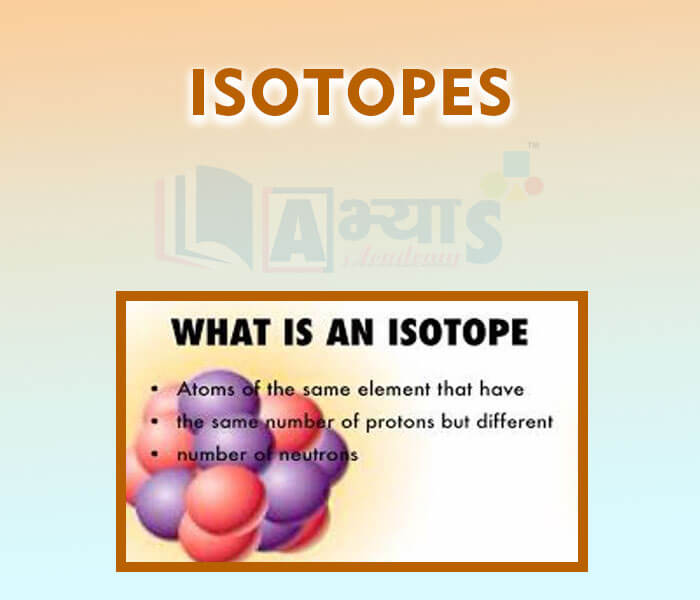Isotopes













Isotopes
Isotopes: These are defined as the atoms of the same element, having the same atomic number but different mass numbers. E.g. there are 3 isotopes of hydrogen atom, namely protium (1H), deuterium (2H) and tritium (3H).
In other words, it can be said that isotopes have same number of protons but differ in the number of neutrons. Each isotope of an element is a pure substance. Since, chemical properties of elements largely depend on their electronic configuration or outermost electrons and as the isotopes of an element have similar electronic configuration.Therefore, isotopes of an element have the same chemical properties. We know that, masses of isotopes of elements are different. Since, physical properties such as density, light scattering etc., depend on mass therefore, these are different for isotopes of an element.
Average Atomic Mass: If an element has no isotopes, the mass of its atom would be the same as the sum of protons and neutrons in it. But if an element occurs in isotopic forms, then from the percentage of each isotopic form, the average mass is calculated as:
Average atomic mass of an element:[(Atomic mass of isotope I x percentage of isotope I) + (Atomic mass of isotope II x percentage of isotope II) +...]
Example: The two isotopic forms of chlorine atom with masses 35u and 37u occur in the ratio of 3:1. Therefore, the average atomic mass of chlorine atom, can be calculated as:
The average atomic mass of chlorine atom:
The 3:1 ratio of isotopes mean 75% of and 25% of
Therefore, average atomic mass of chlorine is
We can calculate the number of neutrons of different isotopes.
Number of Neutrons = Atomic mass - Atomic number
For eg: There are three isotopes of carbon(C) with same numbers of protons and electrons but differ in number of neutrons.
No. of neutrons 12-6 = 6 13-6 =7 14-6 = 8
Here, 35.5 u is not the atomic mass of any one atom of chlorine but it shows that its given amount contains both the isotopes and their average atomic mass is 35.5 u.
NOTE: The fractional atomic masses of elements are due to the fact that all elements have isotopes. The isotopes of an element have different atomic masses. Since the atomic mass of an element is the average atomic mass of all the natural isotopes of that element, most elements have fractional atomic masses.
Applications of Isotopes:
In which one of the following, the number of protons is greater than the number of neutrons but number of protons is less than the number of electrons? | |||
| Right Option : D | |||
| View Explanation | |||
Which of the following are correct : (a) An isotope of iodine (I-131) is used in the treatment of goiter. (b) An isotope of cobalt (Co-60) is used to remove brain tumours and in the treatment of cancer. | |||
| Right Option : C | |||
| View Explanation | |||
How many isotopes are there in hydrogen atom ? | |||
| Right Option : C | |||
| View Explanation | |||
Students / Parents Reviews [10]
I have spent a wonderful time in Abhyas academy. It has made my reasoning more apt, English more stronger and Maths an interesting subject for me. It has given me a habbit of self studying

Yatharthi Sharma
10thIt was a good experience with Abhyas Academy. I even faced problems in starting but slowly and steadily overcomed. Especially reasoning classes helped me a lot.

Cheshta
10thAbout Abhyas metholodology the teachers are very nice and hardworking toward students.The Centre Head Mrs Anu Sethi is also a brilliant teacher.Abhyas has taught me how to overcome problems and has always taken my doubts and suppoeted me.

Shreya Shrivastava
8thMy experience with Abhyas academy is very good. I did not think that my every subject coming here will be so strong. The main thing is that the online tests had made me learn here more things.

Hiya Gupta
8thA marvelous experience with Abhyas. I am glad to share that my ward has achieved more than enough at the Ambala ABHYAS centre. Years have passed on and more and more he has gained. May the centre flourish and develop day by day by the grace of God.

Archit Segal
7thAbhyas Methodology is very good. It is based on according to student and each child manages accordingly to its properly. Methodology has improved the abilities of students to shine them in future.

Manish Kumar
10thAbhyas is a complete education Institute. Here extreme care is taken by teacher with the help of regular exam. Extra classes also conducted by the institute, if the student is weak.

Om Umang
10thMy experience with Abhyas is very good. I have learnt many things here like vedic maths and reasoning also. Teachers here first take our doubts and then there are assignments to verify our weak points.

Shivam Rana
7thIt was good as the experience because as we had come here we had been improved in a such envirnment created here.Extra is taught which is beneficial for future.

Eshan Arora
8thBeing a parent, I saw my daughter improvement in her studies by seeing a good result in all day to day compititive exam TMO, NSO, IEO etc and as well as studies. I have got a fruitful result from my daughter.
